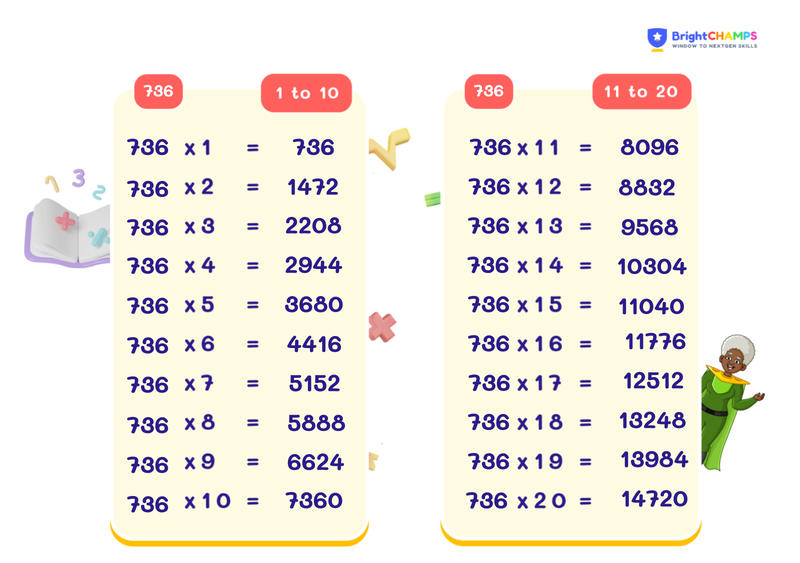
 206 Learners
206 LearnersLast updated on May 26th, 2025

Table of 736

A times table is a chart that shows the results of multiplying a number with whole numbers. Learning the times table helps kids understand multiplication. We use an algebraic system to define multiplication operations in construction, estimation, schoolwork, exams, etc. In this topic, we will learn about the table of 736.
What is the Multiplication Table of 736?
Multiplication was used by people over 4000 years ago. Babylonians are considered the first to use it in clay tablets. Multiplication tables were created as a result of people's search for easier ways to solve problems. Learning multiplication tables has numerous advantages. Kids can answer quickly if they know their times table. It also helps enhance their understanding skills. Being more familiar with the tables improves children's memory and confidence.
Multiplying whole numbers (1, 2, 3, 4, 5, and so on) by 736 gives the products of the multiplication table of 736.
Here are some examples:
736 × 1 = 736
736 × 2 = 736 + 736 = 1,472
736 × 3 = 736 + 736 + 736 = 2,208
736 × 4 = 736 + 736 + 736 + 736 = 2,944
736 × 5 = 736 + 736 + 736 + 736 + 736 = 3,680
736, 1,472, 2,208, 2,944, 3,680, and so on are multiples of 736.

Struggling with Math?
Get 1:1 Coaching to Boost Grades Fast !

736 Times Table Chart
The 736 times table chart shows the multiples of 736. Every result in the chart is obtained by multiplying 736 with other whole numbers, like 1 to 10, and so on.
For example:
736 × 10 = 7,360
736 × 11 = 8,096
736 × 12 = 8,832, and so on.
| TABLE OF 736 (1-10) | |
|---|---|
|
736 x 1 = 736 |
736 x 6 = 4416 |
|
736 x 2 = 1472 |
736 x 7 = 5152 |
|
736 x 3 = 2208 |
736 x 8 = 5888 |
|
736 x 4 = 2944 |
736 x 9 = 6624 |
|
736 x 5 = 3680 |
736 x 10 = 7360 |
| TABLE OF 736 (11-20) | |
|---|---|
|
736 x 11 = 8096 |
736 x 16 = 11776 |
|
736 x 12 = 8832 |
736 x 17 = 12512 |
|
736 x 13 = 9568 |
736 x 18 = 13248 |
|
736 x 14 = 10304 |
736 x 19 = 13984 |
|
736 x 15 = 11040 |
736 x 20 = 14720 |
Tips and Tricks for the Multiplication Table of 736
Understanding the multiplication table of 736 can be challenging because of the larger number involved. But with these tips and tricks, it becomes easier. Let’s look into some:
Break the numbers into smaller parts:
Breaking the numbers into smaller parts will make it easy to learn multiplication.
For example, 736 × 4:
Here, 736 can break into 700 + 36
(700 × 4) + (36 × 4) = 2,800 + 144
= 2,944.
Use of flashcards:
On one side of the flashcard, write the multiplication problems.
For example:
Front: 736 × 3
Back: 2,208.
Repeated patterns:
The unit digits in the 736 times table repeat every 5 multiples.
For example: The unit digits repeat in the cycle: 6, 2, 8, 4, 0. After every 5 multiples, the cycle restarts.

Common Mistakes and How to Avoid Them in Table of 736
While working on the tables of 736, it's common for kids to make some errors. Here are some common mistakes that kids make and the tips on how to avoid them.
Level Up with a Math Certification!
2X Faster Learning (Grades 1-12)


Table of 736 Examples

Problem 1
A factory produces 736 widgets every hour. If the factory operates for 1 hour, how many widgets are produced?

736 widgets.
Explanation
Since the factory produces 736 widgets per hour, in 1 hour, it will produce exactly 736 widgets. For example: 736 × 1 = 736.

Problem 2
A concert event sells tickets, each priced at 736 units. If 5 tickets are sold, how much revenue does the concert generate?

3680 units.
Explanation
To calculate the total revenue from selling 5 tickets, multiply the price of one ticket (736) by the number of tickets sold (5):
736 × 5 = 3680 units.

Problem 3
A library has 736 sections, and each section contains 9 shelves. How many shelves are there in total?

6624 shelves.
Explanation
To find the total number of shelves, multiply the number of sections (736) by the number of shelves per section (9):
736 × 9 = 6624 shelves.

Problem 4
A road construction team lays down 736 meters of asphalt each day. How many meters of asphalt will they lay in 10 days?

7360 meters.
Explanation
To determine the total meters of asphalt laid in 10 days, multiply the daily output (736 meters) by the number of days (10):
736 × 10 = 7360 meters.

Problem 5
A company has 736 employees, and each employee works for 8 hours a day. What is the total number of work hours completed by all employees in one day?

5888 hours.
Explanation
The total work hours completed by all employees in a day is the product of the number of employees (736) and the hours worked per day (8):
736 × 8 = 5888 hours.

Turn your child into a math star!
#1 Math Hack Schools Won't Teach!


FAQs on Table of 736
1.What are the factors of 736?
2.What are the multiples of 736?
3.How can kids practice the table of 736?
4.What is the pattern of the table of 736?
5.Is 736 a prime number?
6.How can poems help children in Singapore memorize the Multiplication Table and Table of 736?
7.Can learning the Multiplication Table influence creativity in solving Table of 736 challenges for kids in Singapore?
8.How do language and cultural differences in Singapore affect the way children learn the Multiplication Table and Table of 736?
9.What role does brain development play in mastering the Multiplication Table and Table of 736 among early learners in Singapore?
Struggling with Math?
Get 1:1 Coaching to Boost Grades Fast !

Important Glossaries for Multiplication Table of 736
- Multiplication: An arithmetic operation to find the total number of objects in groups of equal size.
- Product: The result of multiplying two or more numbers together.
- Factors: Numbers that divide another number exactly without leaving a remainder.
- Multiples: Numbers obtained by multiplying a given number by whole numbers.
- Flashcards: A learning tool where questions are written on one side and answers on the other.
Explore More multiplication-tables
![Important Math Links Icon]() Previous to Table of 736
Previous to Table of 736
About BrightChamps in Singapore


Seyed Ali Fathima S
About the Author
Seyed Ali Fathima S a math expert with nearly 5 years of experience as a math teacher. From an engineer to a math teacher, shows her passion for math and teaching. She is a calculator queen, who loves tables and she turns tables to puzzles and songs.
Fun Fact
: She has songs for each table which helps her to remember the tables




